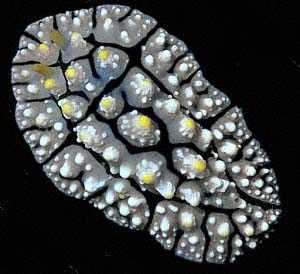
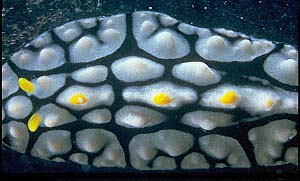
Phyllidia elegans
Bergh, 1869
Order: NUDIBRANCHIA
Suborder: DORIDINA
Family: Phyllidiidae
DISTRIBUTION
Known from coral reef regions throughout the western Pacific and Indian Oceans including the Red Sea.
PHOTO
UPPER: 18 m depth, Phi Phi Island, southern Thailand, 2 Dec. 1989, dorsal view of 35 mm specimen. PHOTO: David Brunckhorst.(Brunckhorst, 1993: Plate 2A);
LOWER: 9 m depth, Whiskey Reef, Red Sea, 14 Jan. 1983, dorsal view of P. multifaria Yonow, 30 mm specimen, Photo: N. Yonow (Brunckhorst, 1993: Plate 2A).
Notes compiled from Brunckhorst, 1993:
Study indicates that P. elegans displays some ontogenetic and individual variation in the arrangement of notal tubercles. However, the coloration and markings of P. elegans serve to clearly distinguish it from its conspecifics. These features include: the pink tubercles which are often capped in yellow; the pale yellow tipped oral tentacles; the pale foot which has a median longitudinal black line on the sole and black lines on its sides; and internally, the black band encircling the junction of pharyngeal bulb and oral tube. Phyllidia varicosa and Phyllidia tula both have a black line on the foot sole, but neither has pink coloration nor black lines on the sides of the foot. Most species of Phyllidiella have pink tubercles but their foregut morphology is very different, and none has yellow coloration or dark ventral markings.
NOTE: Phyllidia multifaria was synonymised by Brunckhorst (1993) with Phyllidia elegans but see Bernard Picton's message suggesting that P. multifaria is a valid species and that Phyllidia schupporum Fahrner & Schrödl, 2000 is an unnecessary synonym.
Reference:
• Brunckhorst, D.J. (1993) The systematics and phylogeny of Phyllidiid Nudibranchs (Doridoidea). Records of the Australian Museum, Supplement 16: 1-107.
Rudman, W.B., 1999 (January 12) Phyllidia elegans Bergh, 1869. [In] Sea Slug Forum. Australian Museum, Sydney. Available from http://www.seaslugforum.net/find/phyleleg
Related messages
Phyllidia elegans from Nth Sulawesi
June 6, 2007
From: Sebastian Ferse
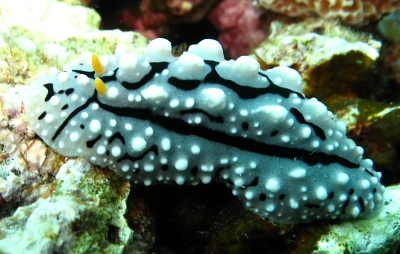
Another slug from North Sulawesi that I'm having trouble with. To me this looks like Phyllidiopsis pipeki, but the yellow rhinophores don't match. I haven't found any Phyllidiopsis with yellow rhinophores. Any ideas what this is? The specimen came from Gorontalo, Traffic Jam dive site, in approximately 5m water depth on rubble substrate.
Locality: Traffic Jam, Gorontalo, 5 m, Gorontalo Province, Sulawesi, Indonesia, Pacific Ocean, 13 March 2007, rubble patch on upper reef slope. Length: 7 cm. Photographer: Sebastian Ferse.
Thanks,
Sebastian
sebastian.ferse@zmt-bremen.de
Ferse, S.C.A., 2007 (Jun 6) Phyllidia elegans from Nth Sulawesi. [Message in] Sea Slug Forum. Australian Museum, Sydney. Available from http://www.seaslugforum.net/find/19725Dear Sebastian,
Yellow rhinophores are a pretty good sign the animal is either a species of Phyllidia or Fryeria. From its colour I would say it is Phyllidia elegans.
Best wishes,
Bill Rudman
Phyllidia elegans from Indonesia
June 4, 2007
From: Sebastian Ferse
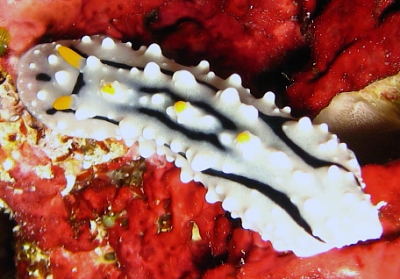
Dear Bill,
Another unknown one from Sulawesi. This one is from a reef top in the Togian Islands. I think it is a Phyllidia sp. - can you tell me what this is?
Locality: Mini Canyon, Kadidiri, Togian Islands, 5m, Central Sulawesi, Indonesia, Pacific Ocean, 10 March 2007, Reef top rich in invertebrate growth (mostly massive and leather corals), found under coral head. Length: 5cm. Photographer: Sebastian Ferse.
Thanks
Sebastian
sebastian.ferse@zmt-bremen.de
Ferse, S.C.A., 2007 (Jun 4) Phyllidia elegans from Indonesia. [Message in] Sea Slug Forum. Australian Museum, Sydney. Available from http://www.seaslugforum.net/find/19731Dear Sebastian,
Although the tubercles are smoother than usual, the yellow rhinophores make it pretty clear that this is Phyllidia elegans
Best wishes,
Bill Rudman
Phyllidia elegans laying eggs
May 30, 2007
From: Mirjam Broos
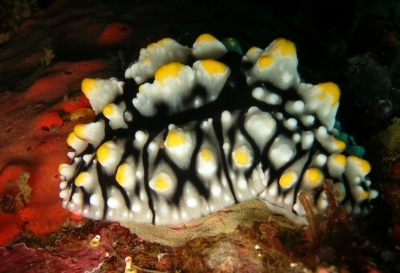
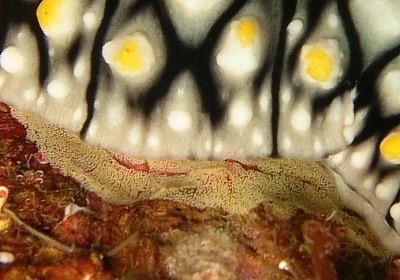
Dear Bill,
As a real beginner in seaslug determination I am not even sure about this species. Can you help me out?
Locality: Angels Windows, Lembeh Strait, max 25 metres, North Sulawesi, Indonesia, Celebes Sea, 09 october 2006, pinnacle. Length: ?. Photographer: Geert Prast.
Mirjam Broos
mirjam.broos@planet.nl
Broos, M., 2007 (May 30) Phyllidia elegans laying eggs. [Message in] Sea Slug Forum. Australian Museum, Sydney. Available from http://www.seaslugforum.net/find/18963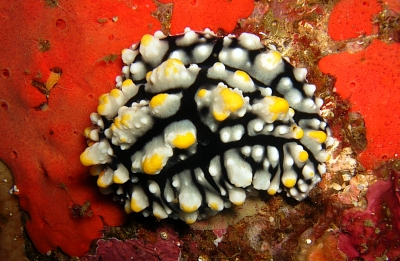
Dear Mirjam,
One good thing about the Forum is that even 'beginners' can make a valuable contribution. This is Phyllidia elegans, and if you look carefully in both your photos you can see that the animal is laying a flat egg ribbon typical of phyllidiids. However we have very little information on the biology of these animals and as far as I know this is the first photo of its egg ribbon. Also its presence on this red-orange sponge is quite interesting as a number of phyllidiids feed on orange sponges of the genus Phakellia. These spiculate sponges are not that easy to identify from photos alone, but it certainly is an interesting co-incidence or correlation, as we know nothing of the biology of P. elegans.
Best wishes,
Bill Rudman
Phyllidia elegans from the Nthn Mariana Ids
December 20, 2003
From: Kenji Kobayashi
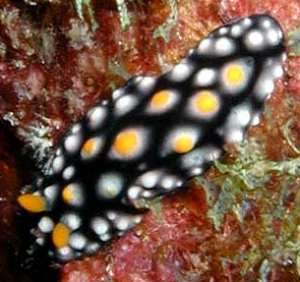
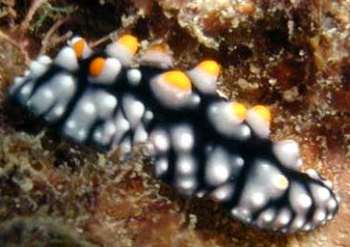
Dear Bill,
Could you identified this spepcies?
The photos were taken in Saipan (Northern Mariana Ids).
Regards
Kenji Kobayashi
squall@gtepacifica.net
Kobayashi, K., 2003 (Dec 20) Phyllidia elegans from the Nthn Mariana Ids. [Message in] Sea Slug Forum. Australian Museum, Sydney. Available from http://www.seaslugforum.net/find/11655Dear Kenji,
At first sight this looks quite like Phyllidia madangensis but in the lower photo we can see a broad band of whitish compound tubercles around the mantle edge. In P. madangensis there are small individual tubercles around the mantle edge, not clusters as in this animal. Although there is more black background than usual, I am pretty sure it is Phyllidia elegans.
Bbest wishes
Bill Rudman
Phyllidia elegans from Vanuatu
October 19, 2003
From: Gary Cobb
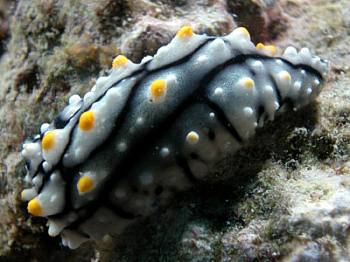
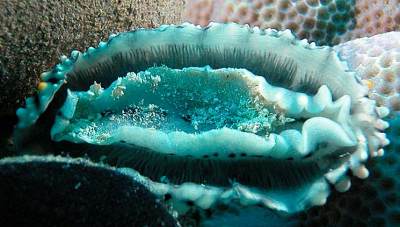
Hi Bill!
Please find attached another photo I took while diving at Aore Island. Santo Vanuatu.
It was 30mm long, 15m depth, Sept 2003
Can you help me ID it? Is that gills I can see underneath?
Gary Cobb
gary@cobb.com.au
Cobb, G., 2003 (Oct 19) Phyllidia elegans from Vanuatu. [Message in] Sea Slug Forum. Australian Museum, Sydney. Available from http://www.seaslugforum.net/find/11193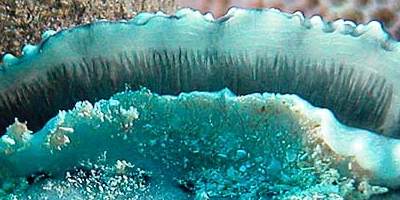
Hi Gary,
This is Phyllidia elegans. The broken black line down the midline of the sole of the foot is a useful character. And yes those are gills you can see on the underside down each side of the body. Phyllidiids have lost the circle of gills around a dorsal anus and replaced it with these leaflets along each side. They are what we call secondary gills.
Best wishes
Bill Rudman
Phyllidia elegans from Myanmar
April 3, 2003
From: Mary Jane Adams
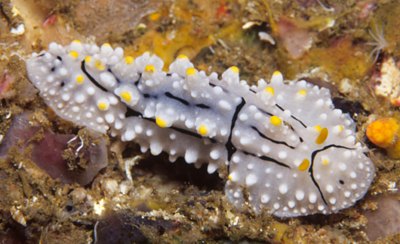
Hi Bill,
I photographed this Phyllidia elegans at Western Rocky, Mergui Archipelago, Andaman Sea, Myanmar on Feb. 25, 2003. It was about 4cm long and 5-10 meters deep.
Best regards,
Mary Jane
divepng@yahoo.com
Adams, M.J., 2003 (Apr 3) Phyllidia elegans from Myanmar. [Message in] Sea Slug Forum. Australian Museum, Sydney. Available from http://www.seaslugforum.net/find/9518Thanks Mary Jane,
It's nice to be able to compare it with your photo of P. alyta from the same region.
Best wishes,
Bill Rudman
Phyllidia elegans colour forms mating
August 16, 2002
From: Erwin Köhler
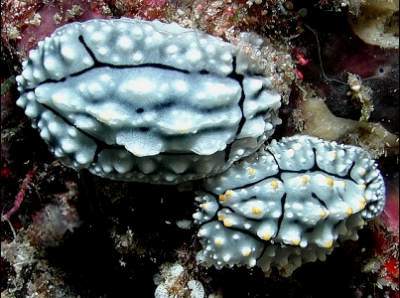
Dear Bill,
here is a shot from the Philippines, Cebu Island, Moalboal, divesite "Umbrella" of 2 colour variants of Phyllidia elegans mating.
size: 36 + 55 mm
depth: 35 m
date: 31 May 2001
Erwin
Erwin@medslugs.de
Köhler, E., 2002 (Aug 16) Phyllidia elegans colour forms mating. [Message in] Sea Slug Forum. Australian Museum, Sydney. Available from http://www.seaslugforum.net/find/7779Thanks Erwin,
Bill Rudman
Phyllidia elegans and P. schupporum
July 4, 2002
From: Bernard Picton
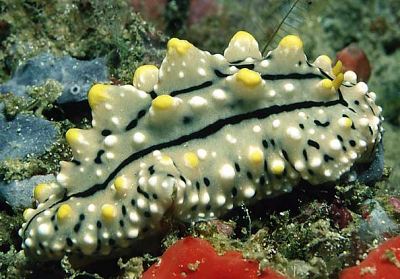
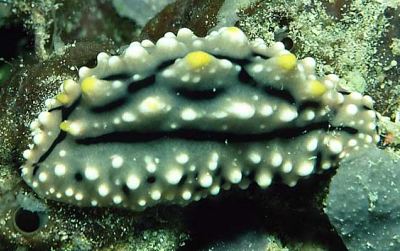
Dear Bill,
To accompany my comments on Phyllidia schupporum and P. multifaria here are some photos of Phyllidia elegans from the Malaysian/Indonesian region for comparison. As I said in that earlier message, consistent differences between P. multifaria and P. elegans seem to include much taller, compound mid-dorsal tubercles in P. elegans; the smaller tubercles in P. elegans are bright white - contrasting with ground colour of mantle, whilst in P. multifaria they are coloured almost the same as the mantle.
UPPER: - 6 Apr 1990 - Sipadan Is, Sabah, Malaysia
LOWER: - 17 Apr 1990 - Sipadan Is, Sabah, Malaysia
Bernard
bernard.picton.um@nics.gov.uk
Picton, B., 2002 (Jul 4) Phyllidia elegans and P. schupporum. [Message in] Sea Slug Forum. Australian Museum, Sydney. Available from http://www.seaslugforum.net/find/6453Thanks Bernard,
At the moment I'll leave all the photos which are identified on the Forum as P. elegans under that name. Do you think that P. multifaria is restricted to the Red Sea or western Indian Ocean?
Best wishes,
Bill Rudman
Phyllidia elegans From Riau, Indonesia
July 2, 2002
From: Alice Lee
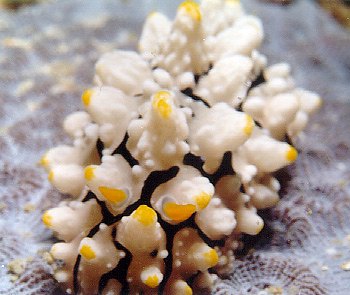
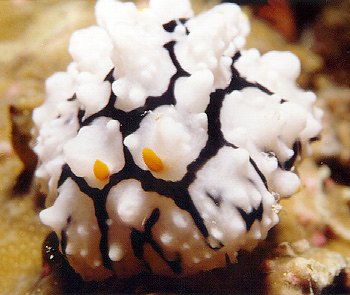
Hi, Bill,
Kindly help to identify which Phyllidia species this is. It is from the Riau Archipelago, Indonesia. Thanks.
Regards,
Alice
alee@dlink.com.sg
Lee, A., 2002 (Jul 2) Phyllidia elegans From Riau, Indonesia. [Message in] Sea Slug Forum. Australian Museum, Sydney. Available from http://www.seaslugforum.net/find/7019Dear Alice,
I have not seen one before with quite such elaborate tubercles, but I am pretty sure this is Phyllidia elegans.
Best wishes,
Bill Rudman
Phyllidia elegans from Malaysia
June 15, 2002
From: Kheong Sann Chan

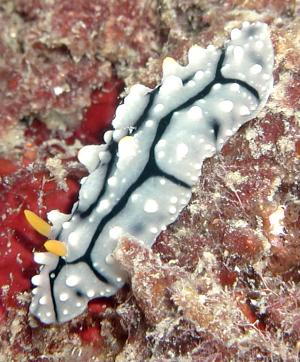
Dear Bill
Here are some more photos from Pulau Dayang off the east coast of west Malaysia.
Location: Dayang, Pinang
Date : 8 June 2002, 1800hrs
Depth : 7m
Kheong Sann Chan
kschan@mail.dsi.nus.edu.sg
Chan, K.S., 2002 (Jun 15) Phyllidia elegans from Malaysia. [Message in] Sea Slug Forum. Australian Museum, Sydney. Available from http://www.seaslugforum.net/find/7216Dear Kheong,
I am pretty sure this is an interesting colour form of Phyllidia elegans. Perhaps it is a juvenile. Can you give us any idea of its length? The yellow tips on some of the tubercles are fairly conclusive evidence. This species also has a black median line along the sole of the foot, but I don't suppose you would have photographed its foot!
Best wishes,
Bill Rudman
Phyllidia elegans from Christmas Island
May 15, 2002
From: W.B. Rudman


Here is a record of Phyllidia elegans from John Hicks' Christmas Island, Indian Ocean collections.
PHOTO: AM C127586, 35 mm long alive. 19 March 1981, in front of shops, on side of rock encrusted with small hydroids and brown algae, 10m, Christmas Is., Indian Ocean. Photo: John Hicks
Best wishes,
Bill Rudman
Phyllidia elegans from Indonesia
May 9, 2002
From: W.B. Rudman


Here is a photo of Phyllidia elegans collected by John Hicks, near Jakarta Indonesia.
PHOTOS: AM C129127, 27 mm long alive. April 1981, Semut Is, near Jakarta, 2 m, on coral rocks. Photo: John Hicks
Best wishes,
Bill Rudman
Phyllidiid from the Red Sea
January 16, 2002
From: Erwin Köhler
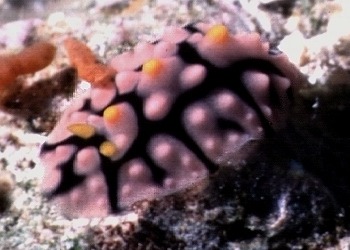
Dear Bill,
Here is one more from the Red Sea, Egypt. I think it is a juvenile, but I have no idea which one? Phyllidia elegans, Fryeria rueppelii or even Phyllidia varicosa are possible ...
Data: 12mm, depth 12m, Egypt, Hamata, Red Sea. Divesite "Shaab Sakara", 30 Dec. 2001.
Erwin
Erwin@medslugs.de
Köhler, E., 2002 (Jan 16) Phyllidiid from the Red Sea. [Message in] Sea Slug Forum. Australian Museum, Sydney. Available from http://www.seaslugforum.net/find/5968Dear Erwin,
Some of these animals can be a bit difficult. I am pretty sure that this is Yonow's (1986) Phyllidia multifaria which Brunckhorst considers to be just a colour form of Phyllidia elegans. I don't suppose you would have a photo of its foot? P. elegans has a black median line on the sole.
Best wishes,
Bill Rudman
Re: Phyllidia elegans?
September 3, 2001
From: Erwin Köhler
Dear Bill,
Concerning my message about photos of possible Phyllidia elegans, Gerhard Rasch writes the yellow Rhinopores are clearly visible in the original slide of ramsch02, though they are almost completely retracted - so I think my guess (Phyllidia elegans) for it is o.k.
Erwin
Erwin@medslugs.de
Köhler, E., 2001 (Sep 3) Re: Phyllidia elegans?. [Message in] Sea Slug Forum. Australian Museum, Sydney. Available from http://www.seaslugforum.net/find/5197Dera Erwin,
If the rhinophores are clearly yellow then my suggestions are ruled out .... which makes P. elegans the only possibility. I must say that the body colouration though is not very typical.
Cheers,
Bill Rudman
Phyllidia elegans?
August 9, 2001
From: Erwin Köhler
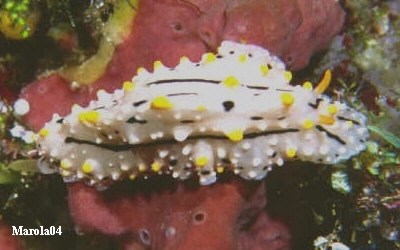
Dear Bill,
Here are 3 photos which I would like to say are all Phyllidia elegans. Harms01 fits exactly the description, while Marola04 is much flatter and has thin black lines, but still large yellow capped tubercles. The last one, Ramsch02, is flatter and has no yellow caps on the tubercles - unfortunately the rhinopores are almost completely retracted, but I think a little yellow tip is visible.
Data:
Harms01: 4cm, 20m depth, April 1994, Indonesia, Bali Island. Photo: Hans-Hermann Harms.
Marola04: 3-4cm, 18m depth, July 2000, Papua New Guinea, Kimbe Bay. Photo: Giovanni Marola.
Ramsch02: 2cm, 10m depth, March 1997, Solomon Islands. Photo: Gerhard Ramsch.
Erwin
Erwin@medslugs.de
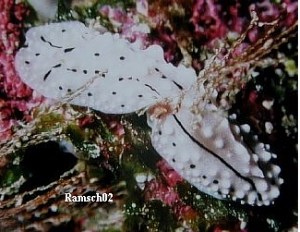
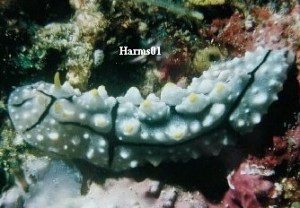
Dear Erwin,
Harms01 and Marola04 are Phyllidia elegans but I think the lower left one, Ramsch02, is another species. I am afraid I can't see the rhinophores so can't be sure. It could be Phyllidiopsis krempfi or Phyllidiella rudmani, neither of which have yellow rhinophores.
Best wishes,
Bill Rudman.
Phyllidia elegans? from Lady Musgrave Island
February 17, 2001
From: David Harasti
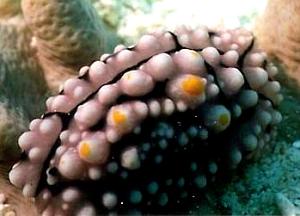
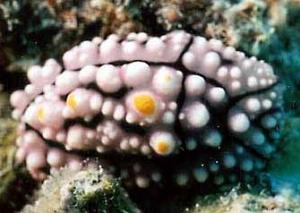
Hi Bill,
This species was found on Lady Musgrave Island - January 2001 [Great Barrier Reef, QLD, Australia]. It was about 3-4 cms long and found in 10 metres of water. Could you please identify it for me, I thought it could possibly be Phyllidia elegans?
Thanks,
David
davidh@dynamite.com.au
Harasti, D., 2001 (Feb 17) Phyllidia elegans? from Lady Musgrave Island. [Message in] Sea Slug Forum. Australian Museum, Sydney. Available from http://www.seaslugforum.net/find/3753Dear David,
I'm pretty sure your identification is correct. The tubercles are smoother than usual, and I can't see the colour of the rhinophores (which should be yellow), but P. elegans is the most likely identification.
Bill Rudman
Phyllidia elegans from Indonesia
December 29, 2000
From: Yasman
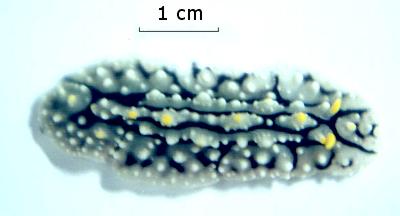
Dear Bill,
Here is a photo of Phyllidia elegans I found in Putri Island, Thousand Islands, Indonesia.
Best regards,
Yasman.
y.yasman@mailcity.com
yasman, 2000 (Dec 29) Phyllidia elegans from Indonesia. [Message in] Sea Slug Forum. Australian Museum, Sydney. Available from http://www.seaslugforum.net/find/3333Thanks Yasman,
Bill Rudman
Phyllidia elegans? from Java
July 21, 2000
From: Aloysia Murni Shintosari
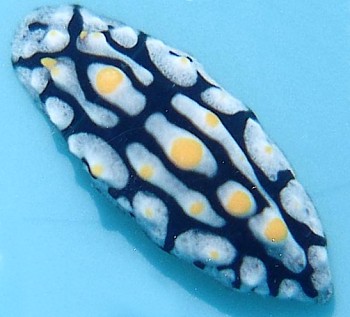
Dear Bill,
Here is another phyllidiid from Thousand Island, Jakarta Bay, Java, Indonesia.
Thank you, hope to hear from you in the near future.
Aloysia
biomurni@biology.aau.dk
Shintosari, A.M., 2000 (Jul 21) Phyllidia elegans? from Java. [Message in] Sea Slug Forum. Australian Museum, Sydney. Available from http://www.seaslugforum.net/find/2732Dear Aloysia,
Sometimes a photo is not enough to make an identification that I am 100% comfortable with. This animal looks as though it is a colour form of Phyllidia varicosa, but it also looks very similar to the photo of the animal Brunckhorst publishes as the 'Phyllidia multifaria - form' of Phyllidia elegans. [see lower photo at top of P. elegans page].
P. elegans is said to have a pinkish base to the tubercles, but that is not always easy to see. One other external difference, which is not visible in the photo, is that P. elegans has black lines on the side of the foot, whereas P. varicosa does not.
I have tentatively identified this animal as P. elegans but I could be wrong.
Best wishes,
Bill Rudman.
What does Phyllidia elegans eat?
June 11, 2000
From: John Brady
Dear Bill,
A local fish store in my area (Utah, Salt Lake City area) is selling Phillidia elegans nudibranchs. They tell me that this nudibranch will eat only the algae that grow in my aquarium and will not bother any of the corals or sponges. Is this correct? Also, could you give me a little more specific information as to what this particular species does eat?
Thank you for your help.
John Brady
john@avilex.com
Brady, J., 2000 (Jun 11) What does Phyllidia elegans eat?. [Message in] Sea Slug Forum. Australian Museum, Sydney. Available from http://www.seaslugforum.net/find/2543Dear John,
We still have a lot to learn about the biology of phyllidiid nudibranchs, including what they eat. What we can be very sure of is that they are sponge feeders and definitely not algal feeders. The specific sponges eaten by about 12 species have been identified, and from the anatomy of the other species there is no reason to believe they are not also sponge feeders.
Concerning keeping phyllidiids in your aquarium. My advice is DON'T. Have a look at my reply to a similar question from Rob See last year. Basically, phyllidiids have special defensive glands in their skin which exude nasty chemicals which at least in some species can kill all the fish in an aquarium overnight. I am not sure if Phyllidia elegans would do so, but it's hardly worth the risk. Also you have no guarantee the shop has correctly identified the slugs it has, since it obviously doesn't know what they eat. Have a look at the photos on this page [above and below your message] of P. elegans to check the identity. If you go to the Species List you will see there are many species of the Phyllidiidae, none of which would be a good idea in an aquarium, unless you are happy to keep them in isolation and watch them slowly starve.
Best wishes,
Bill Rudman.
Phyllidia elegans from Sulawesi
September 18, 1999
From: Carlos Villoch
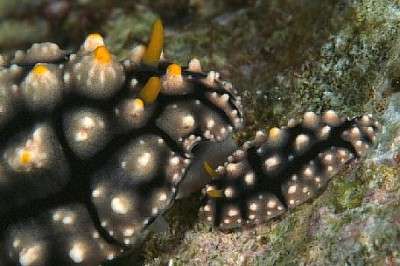
Hello,
I am trying to find the latin name of the nudibranchs of this photo. It was taken in Tukang Besi, SE Sulawesi.
Thank you,
Carlos Villoch,
http://magicsea.com
carlos@magicsea.com
Villoch, C., 1999 (Sep 18) Phyllidia elegans from Sulawesi. [Message in] Sea Slug Forum. Australian Museum, Sydney. Available from http://www.seaslugforum.net/find/1275Dear Carlos,
This is a fairly dark form of Phyllidia elegans. I have had a look at your excellent website. If you would like some of the other nudibranchs identified, I would be happy to help out. Most are well-known species but information on where they were found would be a useful addition to our knowledge.
Best wishes,
Bill Rudman.
Phyllidia elegans from Papua New Guinea
July 11, 1999
From: Des Paroz

Dear Bill
I recently when on a dive holiday in Papua New Guinea (Kavieng & Wallindi) May 1999, and whilst there took a couple of pictures of nudibranchs which I am currently trying to identify for my DIVESITE at http://www.divesite.paroz.com.
Here is one of them. Could you identify it for me please.
Best regards
Des Paroz
des@paroz.com
Paroz, D., 1999 (Jul 11) Phyllidia elegans from Papua New Guinea. [Message in] Sea Slug Forum. Australian Museum, Sydney. Available from http://www.seaslugforum.net/find/1035Dear Des,
This is Phyllidia elegans which is quite common throughout the Indo-West Pacific. Phyllidiids are one of the few groups of nudibranchs the are common during the day on coral reefs and it is thought that the noxious chemicals they have in their skin protects them from predatory fish.
I thought at first the nudibranch was crawling on a finger sponge but on second thoughts it seems to be the fire coral Millepora. If so, its an interesting place for it to be crawling as the nematocysts of Millepora can be quite fierce.
Best wishes,
Bill Rudman.
